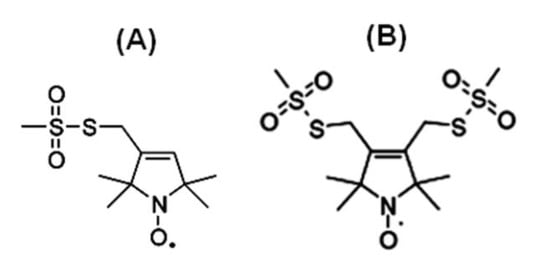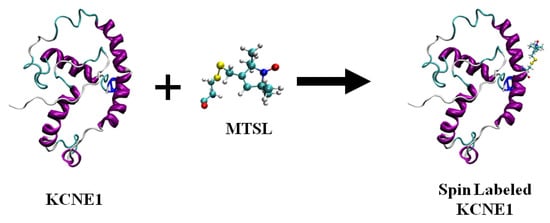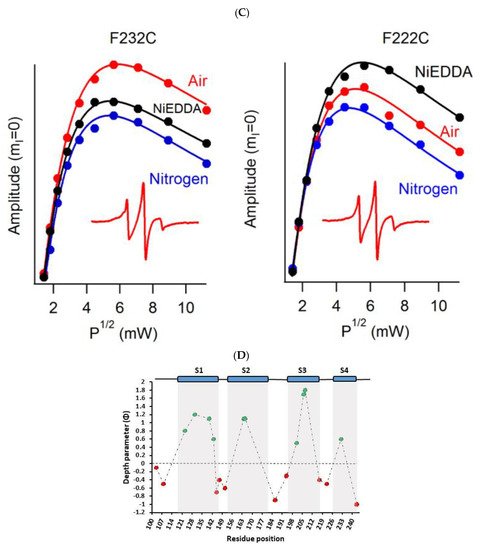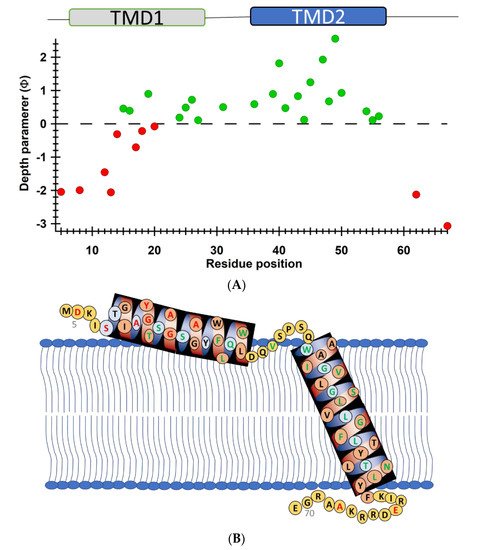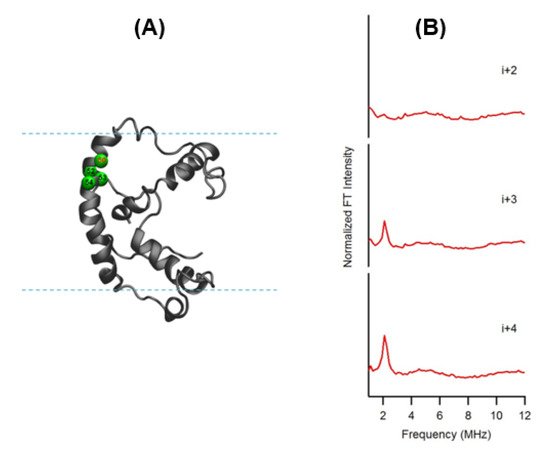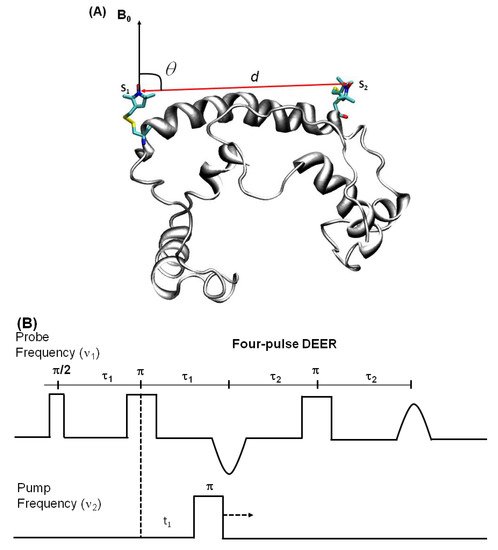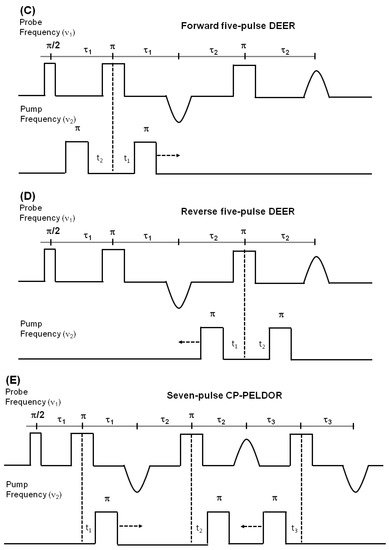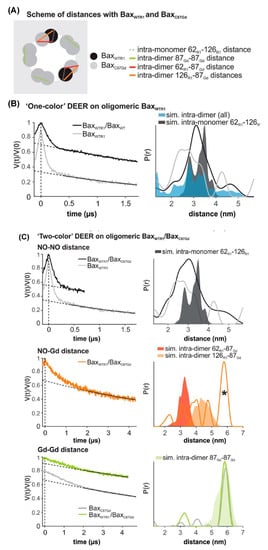DEER is also known as pulsed electron double resonance (PELDOR). DEER has been a widely used biophysical technique for measuring distances between two spin labels on membrane proteins in the range of 18–60 Å
[124][125][126]. In DEER spectroscopy, a dipolar coupling between two spins is measured by monitoring one set of spins while exciting another set of spins with a second microwave frequency, leading to the measurement of the distance between them
[127][124][128]. Nitroxide spin labeling based DEER spectroscopy is very popular for investigating the secondary, tertiary, and quaternary structures and conformational dynamics of a wide variety of macromolecules
[19][40][53][57][116][117][118][119][120][121][122][123][124][125][126][129][130][131][132][133][134]. In addition to nitroxide spin labels, other spin labels such as functionalized chelators of paramagnetic lanthanides (Gd
III), carbon-based radicals (trityl), and metals such as copper (Cu
II) have been recently utilized for DEER measurements on membrane proteins
[52][135][136][137][138]. There is also a disadvantage to using non-nitroxide spin labels. The Gd-based and trityl labels are bulkier than nitrixide spin labels, which can cause perturbation in protein structure and function
[52]. Hence, care must be taken while choosing spin-labeling sites to avoid these perturbations. shows the DEER distance measurement method used for studying membrane proteins. The dipolar coupling frequency (ν
12) is inversely related to the third power of the distance between two spin labels (ν
12 ∝
1/d3)
[127][139]. The most commonly used four pulse DEER sequence is shown in B. In the four pulse DEER sequence, an echo is generated by applying three microwave pulses with specific positions to the one set of spins S
1 at the probe frequency ν
1. Another set of spins, S
2, is flipped by applying a 4th pump microwave pulse at varying positions between the last two probe pulses at the frequency ν
2. Consequently, the sign of the dipolar interaction and the amplitude of spin echo change result in the modulation of the echo amplitude as a function of the position of the pump pulse. The forward five-pulse and the reverse five-pulse DEER sequences are shown in C,D, respectively. In the five-pulse DEER sequence (C,D), similar lengths of the inter-pulse delays are applied. This minimizes the effect of the spin diffusion on relaxation, leading to the increase in the refocused echo intensity when compared to that of the four-pulse DEER sequence. The additional pump pulse also helps extend the dipolar evolution window
[140][141][142]. A seven-pulse Carr-Purcell PELDOR sequence with multiple pump pulses (see E) also leads to improved sensitivity in the measurement of long-range distances.
[140][141][143]. These multipulse DEER experiments introduce echo crossing artifacts in DEER traces
[140][141][143]. These artifacts can be minimized by using eight to thirty two-step phase cycling schemes
[140].
Challenges and Methodological Development in DEER Measurements for Membrane Proteins
Despite the wide application of pulse DEER EPR techniques in structure biology, accurate and precise distance measurements are limited due to difficulties in integral membrane protein sample preparation in their functional environment. The heterogeneous distribution of spin-labeled proteins within the membrane creates local inhomogeneous pockets of high spin concentration leading to much shorter transverse relaxation/phase memory times and poor DEER modulation in more biologically relevant proteoliposomes when compared to water soluble proteins or membrane proteins in detergent micelles
[40][144]. The proton spin diffusion further causes a decrease in the phase memory time. The proton spin diffusion arises due to the presence of hydrogens in the acyl chains of the lipid in addition to those in the solvent and in the protein
[52]. The requirement of a high effective protein concentration in the liposome samples further introduces a strong background contribution that reduces sensitivity, distance range, and experimental throughput
[145]. Additionally, the spin-labeled rotameric motions and protein backbone dynamics also contribute significantly to the width of the DEER distance distribution.
Excellent work has been done in recent years to minimize these limitations. Sample preparations for the reconstitution of membrane proteins have been optimized in the presence of unlabeled proteins, bicelles, nanodics, lipodisq nanoparticles, a low protein/lipid molar ratio, and restricted spin label probes
[40][133][144][146][147][148][149][150][151][152][153]. Using deuterated protein and solvents can also enhance the phase memory times that contribute towards the improvement of data quality
[52]. DEER measurements are also conducted at Q-band to increase sensitivity
[40][144][150]. The introduction of an arbitrary waveform generator (AWG) to EPR has opened new possibilities to improve the pulse sequences in DEER experiments
[140]. The increased excitation band width of the linear chirp pump pulses enhances the modulation depth. This increases the sensitivity of the DEER experiment
[52][140][143]. The use of 5-pulse and 7-pulse sequences also help to increase the dipolar evolution window
[52][140]. Computational approaches using molecular dynamics simulations using DEER distance restraints have also been widely used to refine the structural properties of membrane proteins
[56][133][154][155][156]. These methodological developments have made nitroxide based DEER spectroscopy a rapidly expanding structural biology tool to study complicated integral membrane protein systems.
Nitroxide based SDSL DEER spectroscopy has been applied to investigate a variety of membrane protein systems such as
E. coli integral membrane sulfurtransferase (YgaP), pentameric ligand-gated channel, homodimer protein, bacteriorhodopsin, KCNE1, KCNE3, C99 amyloid precursor protein, KvAP voltage-sensing domain, human dihydroorotate dehydrogenase enzyme (HsDHODH), influenza A M2 protein, outer membrane cobalamin transporter BtuB in intact
E. coli, cardiac Na
+/Ca
2+ exchange (NCX1.1) protein, Na
+/Proline transporter PutP
Escherichia coli, tetrameric potassium ion channel KcsA, α-synuclein, membrane-fusion K/E peptides, ABC transporter MsbA, HCN channels, YetJ membrane protein, ectodomain of gp41, and multidrug transporter LmrP
[56][114][133][146][147][148][152][154][157][158][159][160][161][162][163][164][165][166][167][168][169][170]. SDSL DEER spectroscopy has been recently used to study the oligomerization states of several membrane proteins such as NhaA Na
+/H
+ antiporter of E-coli, KcsA, M2 transmembrane domain, LptA, proteorhodopsin, and Bax oligomers
[60][131][155][158][171][172][173][174][175][176].
A recent application of nitroxide-based spin labeling DEER spectroscopy is the study of a YetJ membrane protein
[152]. YetJ is a member of the widely distributed transmembrane Bax inhibitor motive (TMBIM) family found to be important for the uptake of calcium into bacteria and in mediating a pH-dependent Ca
2+ flux in proteoliposomes. YetJ has seven transmembrane helices with 214 amino acid residues. Li et al. carried out DEER distance measurements on the dual spin-labeled YetJ mutant 44R1/152R1 reconstituted into nanodiscs (NDs)
[152]. This experiment revealed a bimodel-like distance distribution displaying two major peaks centered at 2.7 and 4.1 nm suggesting two conformations of YetJ in NDs
[152]. This study further revealed that the use of the nanodiscs (NDs) provided improvement in the overall signal-to-noise ratio (S/R) of DEER signals and hence increased the resolution in the distance distribution
[152].
DEER spectroscopy was recently applied to study conformational changes in the extracellular loops of the outer membrane cobalamin transporter BtuB in intact
E. coli [176]. BtuB is a 22-stranded β-barrel protein consisting of a 130 residue N-terminal plug or hatch domain in the center. It is a member of the TonB-dependent transporter (TBDT) family. It requires a proton motive force (pmf) and the inner membrane ExbB-ExbD-TonB complex for cyanocobalamin (CN-Cbl) transport. Josesh et al. performed DEER distance measurements on the 188R1-399R1 mutant in
E. coli cells
[176]. DEER distance measurements on 188R1-399R1 cells showed a shorter distance in the apo-state (no Ca
2+ or CN-Cbl) in
E. coli when compared to that in the presence of Ca
2+ or CN-Cbl, suggesting conformation changes induced by ligand binding
[176].
Another recent example of using SDSL DEER spectroscopy is the study of multimeric membrane transport proteins such as sodium and aspartate symporter from
Pyrococcus horikoshii, Glt
ph [177][178]. Glt
ph is a homologue of the mammalian glutamate transporters. It is a homo-trimeric integral membrane protein that controls the neurotransmitter levels in brain synapses
[178]. Glt
Ph transports aspartate together with three Na
+ ions into the cytoplasm accompanied by stoichiometrically uncoupled Cl
− conductance
[177]. Each subunit of Glt
ph has a complex topology with eight transmembrane and two reentrant hairpin segments. Georgieva et al. carried out extensive DEER distance measurements on eight transport domain mutants in detergent and lipid membranes either in the apo state or bound to Na
+ and asp or to DL-
threo-β-bezyloxyaspartate (TBOA)
[178]. These results suggested that the GltPh protomers are distributed between the outward and inward facing conformations in detergent solutions and in lipid bilayers both in the bound and unbound states
[178]. Riederer et al. further utilized DEER distance measurements to evaluate the intra-subunit structural changes in Glt
ph [177]. The DEER measurements on the homomeric V216C/I294C mutants in the presence of Na
+ ions and Asp revealed broad, weakly-structured distance distributions, spanning from 40 to 70 Å, whereas, the heteromeric protein exhibited a single narrow peak at 52 Å
[177]. These distance distributions suggested that the V216C/I294C mutant subunit populates the inward facing state. The corresponding distance in the outward facing state is 34 Å
[177]. These results allowed for straightforward determination of the conformational state of the labeled promoter.
Another recent example of DEER spectroscopy in the literature is an investigation into the active oligomeric Bax proteins
[174][179]. Bax is a Bcl-2 protein that plays a crucial role in apoptosis regulation and execution. Cytosolic Bax monomers oligomerize, when activated, on the surface of mitochondria and change their conformation to form holes into the outer membrane. These proteins are interesting targets for drug development for treatment of chronic lymphocytic leukemia. Bleicken et al. utilized SDSL DEER spectroscopic measurements to obtain 42 distances between 12 different spin-labeled positions of full-length Bax in lipid bilayers mimicking the mitochondrial outer membrane (MOM)
[179]. These distance constraints were used to calculate a three-dimensional structural model of full length active Bax in the membrane. These results suggested that active Bax is organized as assemblies of dimers at the membrane. Additionally, each monomer contains a more flexible domain involved in interdimer interactions and pore formation. Teucher et al. further utilized a combination of spectroscopically distinguishable nitroxide and gadolinium spin labels for DEER measurements to investigate the quaternary structure of active and membrane-embedded Bax oligomers
[174]. DEER distance measurements on the mixture of the Bax
C87Gd with Bax
WTR1 forming a complex protein homo-oligomer detected NO-NO, NO-Gd, and Gd-Gd distances independently. When Bax
WTR1 was mixed with a three-fold excess of Bax
C87Gd, a Gd-Gd distance of 6 nm suggested interactions between the two Bax
C87Gd monomers within a dimer unit, and NO-Gd distances in the range of 2.5–5 nm confirmed that the Bax oligomers containing Bax
C87Gd and Bax
WTR1 monomers are formed
[174]. shows DEER distance measurements on the Bax oligomers
[174]. The background was subtracted from the raw DEER time domain data as shown by the dotted lines in the left panel and the distance distribution (right panel) was obtained using Tikhonov regularization with DeerAnalysis2018
[174]. This study also highlights the usefulness of the orthogonal spin-labeling-based DEER spectroscopy to monitor the membrane-embedded homo- and hetero-oligomers of Bcl-2 proteins.
Figure 8. DEER distance measurements on oligomeric Bax with orthogonal spin labels. (
A) Schematic of the expected distances. (
B,
C) Primary data with background function (left) and time distribution (right). The shaded areas represent corresponding distance simulations based on the structures. (
B) Active Bax
WTR1 mixed with 3-fold excess unlabeled Bax
WT (black) compared to the undiluted Bax
WTR1 (grey). (
C) Upper panel, NO-NO DEER on active Bax
WT with 3-fold excess of Bax
C87Gd compared to the Bax
WT alone (grey). Central panel, NO-Gd DEER on the samples. The asterisk highlights a possible channel cross-talk signal. Bottom panel, Gd-Gd DEER on the sample (green) compared to Bax
C87Gd alone (Grey). (Adapted from
[174] with permission).

